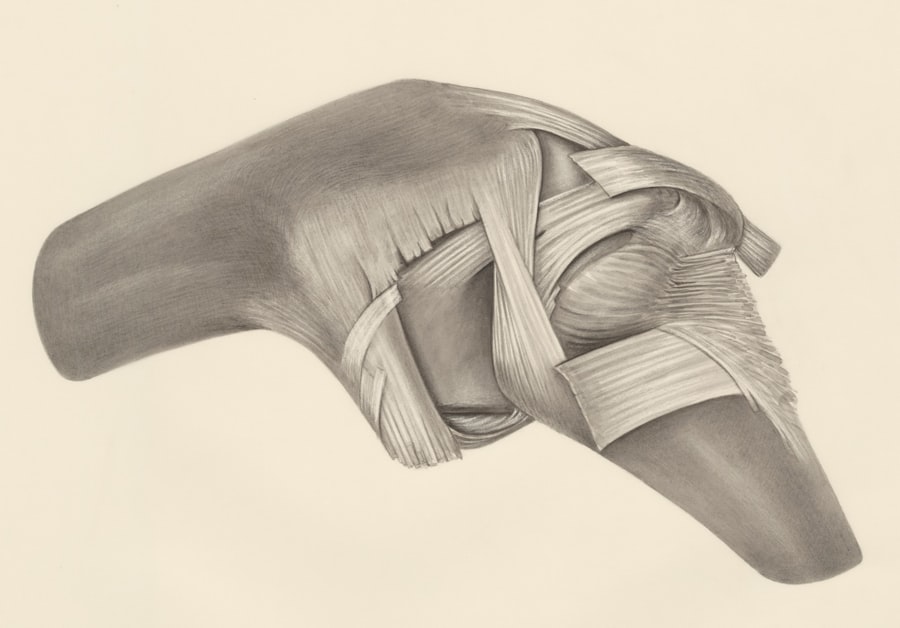Pain threshold is a term that refers to the point at which a person begins to perceive pain. For athletes, understanding and managing this threshold is crucial, as it can significantly influence their performance and endurance. In the world of sports, where pushing physical limits is often the norm, the ability to tolerate pain can be the difference between victory and defeat.
As you engage in rigorous training and competition, your pain threshold becomes a vital aspect of your athletic journey. It is not merely about enduring discomfort; it is about recognizing how pain can be both a barrier and a motivator. The relevance of pain threshold in athletics extends beyond mere physical sensations.
It encompasses psychological resilience, mental fortitude, and the ability to push through barriers that would typically deter others. As you strive for excellence in your sport, understanding your pain threshold can help you develop strategies to enhance your performance. This article will delve into various factors that contribute to an athlete’s pain threshold, exploring the physiological, psychological, and environmental elements that shape your experience of pain during intense physical activity.
Key Takeaways
- Pain threshold is the point at which a person feels pain, and it is relevant in the context of athletes and endurance as it can impact their performance and ability to push through physical challenges.
- Endorphins are released during physical activity and can affect an athlete’s perception of pain, allowing them to push through discomfort and fatigue.
- Consistent training and physical conditioning can raise an athlete’s pain threshold, enabling them to endure more intense physical challenges.
- Mental toughness plays a significant role in an athlete’s ability to push through pain barriers and continue performing at a high level during endurance activities.
- Athletes use various distraction techniques to divert their attention from the sensation of pain during intense physical activity, allowing them to maintain performance levels.
The Role of Endorphins:
When you engage in physical activity, your body responds by releasing endorphins—natural chemicals that act as pain relievers. These endorphins bind to the receptors in your brain, reducing the perception of pain and creating a sense of euphoria often referred to as the “runner’s high.” This biochemical response is particularly significant for athletes, as it allows you to push through discomfort and fatigue during training or competition.
As you become more accustomed to intense physical exertion, your body becomes adept at producing endorphins in response to stress. This adaptation can lead to an increased tolerance for pain, allowing you to train harder and longer without succumbing to discomfort. The interplay between endorphins and your perception of pain is a crucial aspect of athletic performance.
By understanding how these natural chemicals work, you can harness their power to improve your endurance and resilience in the face of physical challenges.
Training and Adaptation:

Consistent training plays a pivotal role in raising your pain threshold. As you engage in regular physical activity, your body undergoes various adaptations that enhance its ability to cope with discomfort. Muscles become stronger, cardiovascular efficiency improves, and your overall stamina increases.
These physiological changes contribute to a higher pain threshold, enabling you to endure greater levels of stress during workouts or competitions. The more you train, the more your body learns to manage pain effectively. Moreover, the process of adaptation is not solely physical; it also involves mental conditioning.
As you push through challenging workouts, you develop a greater understanding of your limits and learn how to navigate discomfort. This mental resilience is essential for athletes who often face intense physical challenges. By consistently exposing yourself to discomfort through training, you can gradually expand your pain threshold, allowing you to perform at higher levels when it matters most.
Mental Toughness:
| Aspect | Metric |
|---|---|
| Resilience | Ability to bounce back from setbacks |
| Focus | Ability to concentrate on the task at hand |
| Confidence | Belief in one’s abilities and decisions |
| Determination | Persistence and perseverance in the face of challenges |
Mental toughness is a critical component of endurance sports, as it enables you to push through pain barriers that might otherwise hinder your performance. This psychological aspect involves cultivating a mindset that embraces discomfort and views it as an integral part of the athletic experience. Athletes who possess mental toughness are often able to maintain focus and determination even when faced with significant pain or fatigue.
This ability to persevere in the face of adversity can set you apart from competitors who may falter under pressure. Developing mental toughness requires practice and self-awareness. You may find that setting specific goals, visualizing success, or employing positive self-talk can help strengthen your resolve during challenging moments.
By training your mind alongside your body, you can create a powerful synergy that enhances your overall performance. Embracing the discomfort associated with pushing your limits can ultimately lead to greater achievements in your athletic pursuits.
Distraction Techniques:
During intense physical activity, athletes often employ various distraction techniques to mitigate the sensation of pain. These strategies can range from focusing on breathing patterns to engaging in positive self-talk or visualizing success. By redirecting your attention away from discomfort, you can create a mental buffer that allows you to continue performing at a high level despite the physical challenges you face.
For instance, some athletes find that listening to music or podcasts during workouts helps them maintain focus and distracts them from feelings of fatigue or pain. Others may use visualization techniques, imagining themselves crossing the finish line or achieving their goals. These distraction methods not only help manage pain but also enhance motivation and enjoyment during training sessions.
By incorporating such techniques into your routine, you can develop a more resilient mindset that enables you to tackle even the most demanding challenges.
The Influence of Genetics:

Genetics plays a significant role in determining an individual’s pain threshold, influencing how you perceive and respond to discomfort. Some people are naturally predisposed to have a higher tolerance for pain due to genetic factors that affect their nervous system and pain receptors.
While genetics may provide a baseline for your pain threshold, it is essential to recognize that environmental factors and personal experiences also shape this aspect of your athletic journey. You may find that consistent training, mental conditioning, and effective coping strategies can help elevate your pain threshold over time, regardless of your genetic predisposition. Understanding the interplay between genetics and personal effort can empower you to take control of your athletic development and enhance your performance.
The Impact of Injuries:
Injuries are an unfortunate reality for many athletes, but they can also lead to an increased pain threshold over time. As you endure and recover from injuries, your body adapts by recalibrating its response to pain signals. This process often involves developing greater resilience and tolerance for discomfort as you learn to navigate the challenges associated with rehabilitation and recovery.
Moreover, overcoming injuries can foster a deeper understanding of your body’s limits and capabilities. You may find that the experience of dealing with pain during recovery enhances your mental toughness and determination when returning to competition. By embracing the lessons learned from injuries, you can emerge as a stronger athlete with an elevated pain threshold that allows you to face future challenges with confidence.
The Connection Between Pain and Performance:
The relationship between an athlete’s ability to tolerate pain and overall performance is complex yet significant. In many sports, the capacity to endure discomfort can directly impact your success on the field or in competition. Athletes who can push through pain often find themselves able to maintain higher levels of intensity and focus during critical moments, leading to improved performance outcomes.
However, it’s essential to recognize that while a higher pain threshold can be advantageous, it should not come at the expense of injury or long-term health. Striking a balance between pushing through discomfort and listening to your body is crucial for sustainable performance in sports. By developing strategies that enhance both your physical and mental resilience, you can optimize your ability to tolerate pain while ensuring that you remain healthy and competitive.
The Importance of Proper Recovery:
Recovery is an integral part of any athlete’s training regimen, playing a vital role in maintaining a high pain threshold over time. Adequate rest allows your body to repair itself after intense workouts, reducing the risk of injury and ensuring that you are prepared for future challenges. Incorporating recovery strategies such as stretching, hydration, nutrition, and sleep into your routine can significantly impact how well you manage pain during training and competition.
Moreover, understanding the importance of recovery can help you develop a more nuanced approach to training. Rather than viewing rest as a sign of weakness or inactivity, recognizing its value in enhancing performance can empower you to prioritize recovery as part of your overall strategy for success. By taking care of your body through proper recovery practices, you can maintain a higher pain threshold while minimizing the risk of burnout or injury.
The Potential Risks:
While having a high pain threshold can be advantageous for athletes, it also comes with potential risks that should not be overlooked. Ignoring pain signals or pushing through discomfort without proper awareness can lead to serious injuries or long-term damage. It is essential for athletes like yourself to strike a balance between resilience and self-care, ensuring that you listen to your body when it signals distress.
Being attuned to your body’s signals is crucial for maintaining long-term health and performance. Developing an awareness of when it is appropriate to push through discomfort versus when it is necessary to rest or seek medical attention can make all the difference in your athletic career. By prioritizing both mental toughness and self-care, you can navigate the complexities of endurance sports while minimizing risks associated with a high pain threshold.
Conclusion:
In summary, several key factors contribute to an athlete’s higher pain threshold, each playing a vital role in shaping performance in sports. From physiological adaptations resulting from consistent training to the psychological resilience developed through mental toughness, these elements work together to enhance your ability to endure discomfort during intense physical activity. Additionally, understanding the influence of genetics, the impact of injuries, and the importance of recovery further enriches this complex relationship between pain tolerance and athletic performance.
As you continue on your athletic journey, recognizing the significance of managing your pain threshold will empower you to optimize both training and competition experiences. By embracing strategies that enhance resilience while prioritizing self-care, you can navigate the challenges of endurance sports with confidence and determination—ultimately leading to greater achievements in your pursuit of excellence.
Athletes are often noted for their remarkable ability to endure pain, a trait that has intrigued scientists and sports enthusiasts alike. This heightened pain threshold is believed to be a result of both physiological and psychological factors, including the rigorous training regimens that athletes undergo, which condition their bodies and minds to tolerate discomfort. A related article on this topic can be found on Freaky Science, which delves into the science behind why athletes can withstand more pain than the average person. For more insights, you can read the full article by visiting Freaky Science.
WATCH NOW! Your Brain Blocks Superhuman Strength – The Secret of the Pain Barrier
FAQs
What is a pain threshold?
The pain threshold is the point at which a person begins to feel physical pain. It varies from person to person and can be influenced by a variety of factors including genetics, environment, and individual pain tolerance.
Do athletes have higher pain thresholds?
Research suggests that athletes may have higher pain thresholds than non-athletes. This is believed to be due to a combination of physiological, psychological, and training-related factors.
What physiological factors contribute to athletes having higher pain thresholds?
Physiologically, athletes may have higher pain thresholds due to their bodies being conditioned to handle physical stress and discomfort. Regular exercise and training can lead to the release of endorphins, which are natural pain-relieving hormones, and can increase pain tolerance.
How do psychological factors play a role in athletes’ pain thresholds?
Psychologically, athletes may be more accustomed to pushing through discomfort and pain as part of their training and competition. They may also have a higher level of mental toughness and resilience, allowing them to endure higher levels of pain.
Can training and conditioning affect an athlete’s pain threshold?
Yes, regular training and conditioning can increase an athlete’s pain threshold. By exposing their bodies to physical stress and discomfort during training, athletes can gradually build up their tolerance to pain.
Are there any potential drawbacks to having a higher pain threshold as an athlete?
While having a higher pain threshold can be beneficial for athletes in terms of pushing through physical challenges, it can also lead to the risk of ignoring or downplaying serious injuries. It’s important for athletes to be mindful of their bodies and seek appropriate medical attention when needed.
